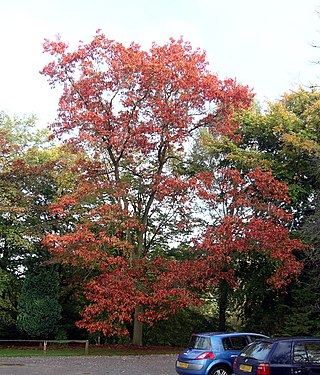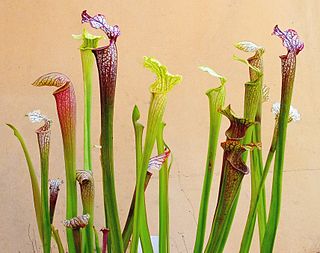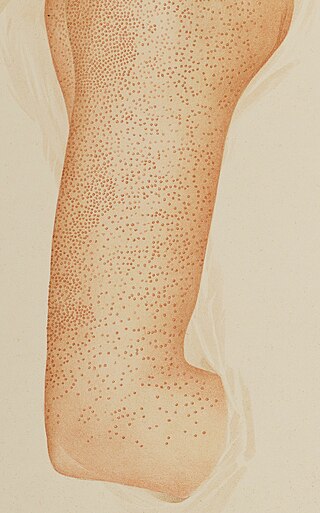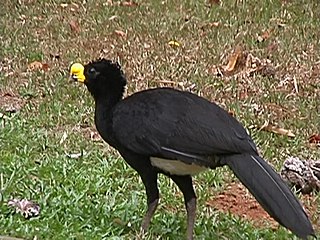
Quercus rubra, the northern red oak, is an oak tree in the red oak group. It is a native of North America, in the eastern and central United States and southeast and south-central Canada. It has been introduced to small areas in Western Europe, where it can frequently be seen cultivated in gardens and parks. It prefers good soil that is slightly acidic. Often simply called red oak, northern red oak is so named to distinguish it from southern red oak (Q. falcata), also known as the Spanish oak. Northern red oak is sometimes called champion oak.

The summer tanager is a medium-sized American songbird. Formerly placed in the tanager family (Thraupidae), it and other members of its genus are now classified in the cardinal family (Cardinalidae). The species's plumage and vocalizations are similar to other members of the cardinal family.

Alnus rubra, the red alder, is a deciduous broadleaf tree native to western North America.

Sarracenia is a genus comprising 8 to 11 species of North American pitcher plants, commonly called trumpet pitchers. The genus belongs to the family Sarraceniaceae, which also contain the closely allied genera Darlingtonia and Heliamphora.

Ulmus rubra, the slippery elm, is a species of elm native to eastern North America. Other common names include red elm, gray elm, soft elm, moose elm, and Indian elm.

Myrica rubra, also called yangmei, yamamomo, Chinese bayberry, red bayberry, yumberry, waxberry, or Chinese strawberry is a subtropical tree grown for its fruit.

Pityriasis rubra pilaris refers to a group of chronic disorders characterized by reddish orange, scaling plaques and keratotic follicular papules. Symptoms may include reddish-orange patches on the skin, severe flaking, uncomfortable itching, thickening of the skin on the feet and hands, and thickened bumps around hair follicles. For some, early symptoms may also include generalized swelling of the legs, feet and other parts of the body. PRP has a varied clinical progression and a varied rate of improvement. There is currently no known cause or cure for PRP.

The great curassow is a large, pheasant-like bird from the Neotropical rainforests, its range extending from eastern Mexico, through Central America to western Colombia and northwestern Ecuador. Male birds are black with curly crests and yellow beaks; females come in three colour morphs, barred, rufous and black. These birds form small groups, foraging mainly on the ground for fruits and arthropods, and the occasional small vertebrate, but they roost and nest in trees. This species is monogamous, the male usually building the rather small nest of leaves in which two eggs are laid. This species is threatened by loss of habitat and hunting, and the International Union for Conservation of Nature has rated its conservation status as "vulnerable".
The elm cultivar Ulmus 'Rubra' was reputedly cloned from a tree found by Vilmorin in a wood near Verrières-le-Buisson in the 1830s. It was listed in the 1869 Catalogue of Simon-Louis, Metz, France, as Ulmus campestris rubra, and by Planchon in de Candolle's Prodromus Systematis Naturalis Regni Vegetabilis (1873) as Ulmus libero-rubra: 'Orme à liber rouge' [:elm with red inner bark]. Elwes and Henry (1913) and Bean (1936) listed it as Ulmus montana [:U. glabraHuds.] var. libro-rubro, the former stating that the tree appeared "identical" to Simon-Louis's Ulmus campestris rubra. A specimen in the Zuiderpark, The Hague, was identified in 1940 as a wych elm cultivar, U. glabraHuds.libero rubro.
The elm cultivar Ulmus 'Folia Rubra' was listed as Ulmus campestris foliis rubris by Louis de Smet in his catalogue of 1877, and Edouard Pynaert van Geert in the same year who obtained the tree from M. Gaujard of Wetteren, Belgium. An U. campestris fol. rubrisHort. was distributed by the Späth nursery, Berlin, in the 1890s and early 1900s.
The hybrid elm cultivar Ulmus 'Hamburg' was originally raised by the Plumfield Nurseries, Fremont, Nebraska, circa 1932, after its discovery by Mr. Lloyd Moffet in a bed of Siberian Elm Ulmus pumila seedlings from Tekamah. It was later marketed by Interstate Nurseries, Hamburg, Iowa, from 1948, as 'Interstate's New Hamburg Hybrid Elm'. Green stated that it was originally said be a hybrid of Ulmus pumila and Ulmus americana, but the Hamburg Nurseries of Iowa made no such claim for it in their catalogues from 1948 onwards. It is now considered more likely that Ulmus rubra was the male parent, as it was also known as 'Hybrid Chinese Elm', and therefore probably synonymous with Plumfield Nurseries' 'Hybrid elm' of the same date, a known crossing of U. pumila and U. rubra, – and so, perhaps, also synonymous with Ulmus × intermedia 'Fremont', an elm of the same parentage found a little later in Plumfield Nurseries.
The hybrid elm cultivar Ulmus × intermedia 'Rosehill' is an American hybrid cultivar originally raised by the Rose Hill Nurseries of Kansas City, Missouri, as Ulmus 'Rose Hill', without species names, from a selection of Ulmus pumila × Ulmus rubra seedlings made in 1951.
The Field Elm cultivar Ulmus minor 'Microphylla Rubra' was listed by C. de Vos in Handboek, 203, 1887, as Ulmus campestris microphylla rubra but did not include a description.

Festuca rubra is a species of grass known by the common name red fescue, creeping red fescue or the rush-leaf fescue. It is widespread across much of the Northern Hemisphere and can tolerate many habitats and climates. It is best adapted to well-drained soils in cool, temperate climates; it prefers shadier areas and is often planted for its shade tolerance. Wild animals browse it, but it has not been important for domestic forage due to low productivity and palatability. It is also an ornamental plant for gardens.

Plumeria rubra is a deciduous plant species belonging to the genus Plumeria. Originally native to Mexico, Central America, Colombia and Venezuela, it has been widely cultivated in subtropical and tropical climates worldwide and is a popular garden and park plant, as well as being used in temples and cemeteries. It grows as a spreading tree to 7–8 m (23–26 ft) high and wide, and is flushed with fragrant flowers of shades of pink, white and yellow over the summer and autumn.
Ulmus ellipticaKoch is a disputed species of elm, native to the Caucasus, where Koch reported that it formed extensive woods, and ranging north to southern Ukraine. The tree reminded Koch of the elm then called Ulmus majorSmith, except in its samara. Others thought it closely related to U. glabra, but to resemble U. rubra in its samara. Many authorities consider U. ellipticaKoch just a regional form of U. glabra, though Henry, Bean and Krüssman list the Caucasus tree as a species in its own right. U. ellipticaKoch is likewise distinguished from U. scabraMill. [:U. glabraHuds.] in some Armenian and Russian plant lists.
Granulosis rubra nasi is a rare familial disease of children, occurring on the nose, cheeks, and chin, characterized by diffuse redness, persistent excessive sweating, and small dark red papules that disappear on diascopic pressure.

The blacklip abalone, Haliotis rubra, is an Australian species of large, edible sea snail, a marine gastropod mollusk in the family Haliotidae, the abalones.

Oncideres is a genus of longhorn beetles of the subfamily Lamiinae, containing more than 120 species in the nearctic and neotropics.
Ulmus × intermediaElowsky is a natural hybrid elm occurring across Nebraska and several other Midwestern states, derived from the crossing of Ulmus rubra and Ulmus pumila. As Red Elm U. rubra is far less fertile, and highly susceptible to Dutch elm disease (:DED), it could eventually be hybridized out of existence by U. × intermedia. The hybrid was first reported from the wild in the Chicago region in 1950 and was provisionally named U. × nothaWilhelm & Ware in 1994.











